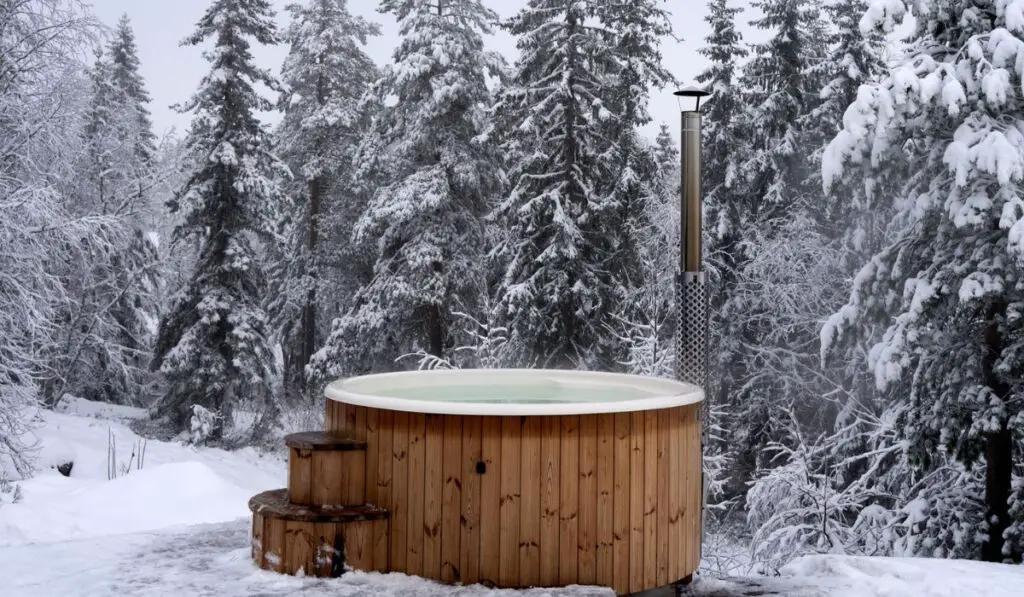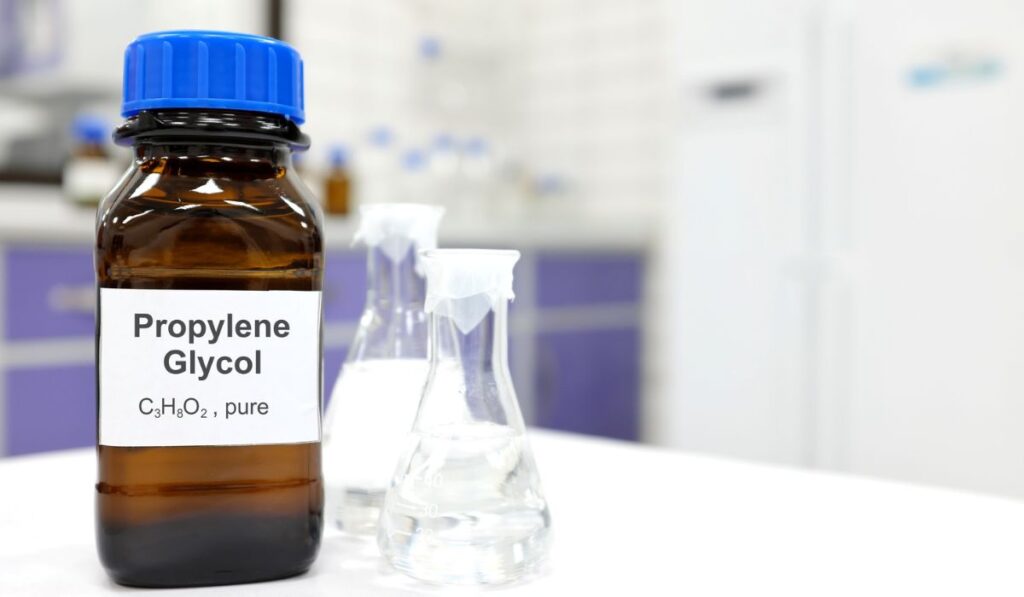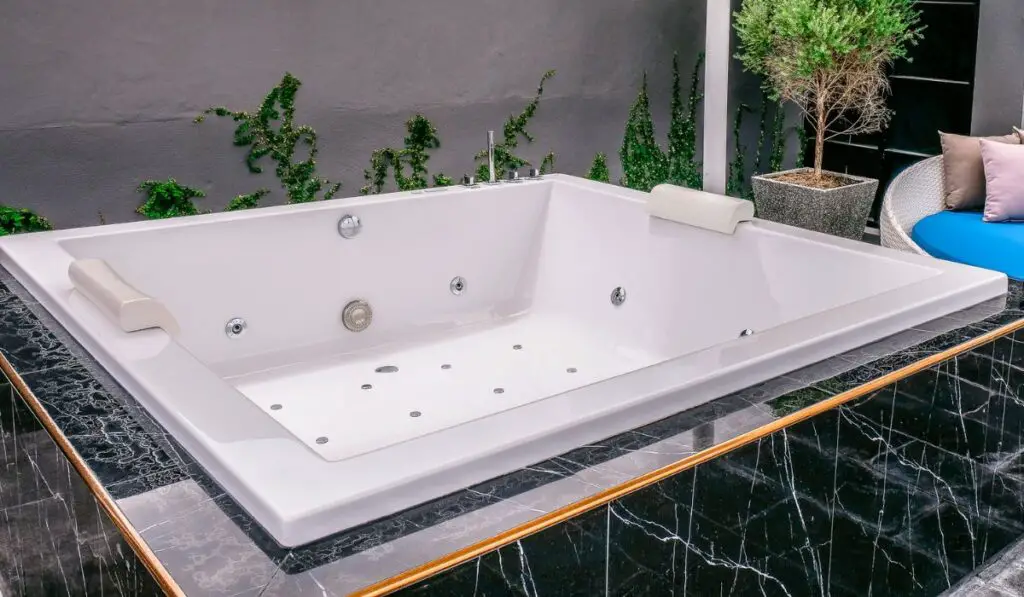A severe drop in winter temperatures can cause devastating effects on your hot tub, especially if no one will look after it. As such, you might be considering using antifreeze to protect the plumbing and equipment. Great! But where do you start?
You can put antifreeze in your hot tub, but use propylene glycol, as it is safe and recommended for hot tubs. Carefully pour the propylene glycol antifreeze into your filter standpipes, jets, and other openings. Don’t use ethylene glycol, as it’s toxic and only meant to cool car engines.
To be blunt, there’s a lot more to know about winterizing your hot tub and using antifreeze. Let’s dive in so you can figure out how to do everything safely and correctly.
Is it Safe to Put Antifreeze in a Hot Tub?

It is absolutely safe to put antifreeze in your hot tub to keep the pipes from freezing in the winter. However, you should not use any antifreeze containing ethylene glycol, like the one you’d use in your car.
Ethylene glycol is toxic and should never get into a hot tub.
While you can safely add antifreeze to your hot tub, you should only do so if you’re sure neither you nor anyone else wants to use the tub. You don’t pour any chemicals into your hot tub and use it unless it’s meant to treat it for regular usage.
What Kind of Antifreeze Do You Use to Winterize a Hot Tub?
Propylene glycol is the kind of antifreeze you should use to winterize your hot tub. It’s non-toxic, so you can use it safely without evacuation at startup. Do not use ethylene glycol products, like those used as coolants in cars.
While adding antifreeze may seem like just pouring in a pack of any other hot tub chemicals, it takes proper precaution. At the same time, it’s nothing like rocket science, but you must stick with a few guidelines.
Why Use Antifreeze?
By adding propylene glycol antifreeze, you won’t have to worry about spending your hard-earned bucks on repair and maintenance once you drain the tub.
Remember, water expands when it freezes, and any water left in the pipes without antifreeze will likely burst the pipes in the winter.
But if you apply antifreeze, you’ll be able to reopen the tub in the following months when warm temperatures arrive. You won’t deal with leakages, broken pipes, defunct pumps, or filters.
That said, winterizing the hot tub is your ideal option if you’re going out of town for more than four weeks and no one will pop in to take care of it. In that case, add antifreeze to protect the tub’s plumbing and equipment in the cold months.
But if someone wants to use your hot tub during the winter, you don’t have to drain it or put in antifreeze. So as practical and sensible as it can be, winter is indeed the perfect time to soak in a hot tub.
What Happens if You Don’t Add Antifreeze
If you drain your hot tub poorly while going for that winter vacation and don’t put in antifreeze, you’re opening doors to all manner of problems.
Just like shocking, regular cleaning and changing the water are necessary hot tub maintenance procedures; you can’t do away with antifreeze once you drain it for the winter.
Many articles online say winterizing a hot tub is unnecessary, but those may be written by manufacturers of specific hot tub models. Others are written by amateurs who may not even own a hot tub in the first place, so watch out.
Since you may not flush out all the water from your hot tub’s system, some residual water may freeze in the pipes and burst them.
This will cause serious leaks when you reopen the tub, not to mention it takes a toll on the performance of other equipment like the heater and pump.
The best use of your time and money would be to buy hot tub antifreeze and follow the proper winterization procedure. Otherwise, you’ll incur high repair costs or even have to replace the entire hot tub.
What is Propylene Glycol Antifreeze?

Propylene glycol (on Amazon) is the kind of antifreeze recommended for use in hot tubs, spas, boats, RVs, vacation homes, and campers. It’s typically made with a plant-derived additive to offer -50 ℉ burst protection for your pipes.
According to the Environmental Protection Agency (EPA), propylene glycol is safer for use as antifreeze than ethylene glycol.
It contains a biodegradable, non-toxic formula which makes it safe for use, so it doesn’t pose a serious threat upon incidental contact with people, pets, and wildlife.
However, people and pets should not consume propylene glycol antifreeze products as they may have other harmful chemicals. Use safety gloves and splash goggles while handling propylene glycol antifreeze.
You also want to ensure the room is well-ventilated, as poor handling and exposure to the product may cause headaches, lightheadedness, dizziness, and passing out.
How Do You Winterize Your Hot Tub?
If you’re not a veteran hot tub owner, you’re probably wondering what it means to winterize it. But there’s no mojo stuff here, and neither is it too complicated.
We’re only draining the tub, cleaning it, and adding antifreeze in the lines to protect them from damage in the winter when you won’t be using the tub.
Follow these steps to winterize your hot tub and prevent water from freezing in the pipes and bursting them:
1.) Gather All the Supplies You Need
Before you drain your tub and carry out any steps, be sure to get these pieces of equipment for the job:
- A wet and dry vacuum cleaner (preferably a Shop Vac)
- Towels for wiping the tub’s shell and sucking up water from the bottom
- Distilled vinegar or denatured alcohol
- A mild acrylic cleaning agent
- Propylene glycol antifreeze
- A long funnel for pouring in antifreeze
- Garden hose to drain the tub from its drainage plug
If you want to empty the tub faster, you can use a sump pump, bilge pump, or any other small submersible pump.
2.) Check Your Owner’s Manual
Since most owner’s manuals have specific instructions for winterizing various tub models, you must review yours carefully. Also, some manufacturers will advise against winterizing their hot tub models or using antifreeze.
3.) Use a Line Flush Product to Clean the Plumbing
Cleaning the plumbing with a line flush chemical helps prevent mold and algae growth.
Here’s how to do it in 5 simple steps:
- Power off the tub.
- Carefully remove your hot tub’s filters.
- Power on the tub once more and turn the jets on full.
- Pour the suggested amount of line flush product into the filter housings.
- Let the jets run for up to 30 minutes.
4.) Drain the Hot Tub and Clean it Thoroughly

Once you’ve flushed out the plumbing, turn off the power and drain the tub. Then, attach a garden hose to the tub’s bottom drain spout and let it naturally.
A sump pump or bilge pump will significantly speed up the process, usually taking 15 minutes or less.
You want to ensure the water empties into a safe area, like a storm drain, because most of the chemicals you use to treat your hot tub are toxic to plants and animals.
Next, thoroughly clean the hot tub’s shell with a mildly abrasive sponge and a hot tub acrylic cleaning agent. Rinse it thoroughly with clean water and let it dry.
5.) Drain the Air Blower
You may skip this step if your hot tub has no air blower. Otherwise, here’s how to drain the blower:
- Carefully disconnect the heater.
- Replace the hot tub cover and turn the heater back on temporarily.
- Run the air blower for 30 seconds to 1 minute to clear its air channels.
- Turn off the blower, power off the hot tub, and remove the cover.
6.) Loosen the Unions & Drain Plugs
Loosen the unions or couplers around the pump and heater so you can drain residual water from the pipes. Use a wet and dry vacuum to suck them dry for the best results.
Remember, any water left in the pipes will freeze and expand in the winter months, bursting the pipes and damaging the plumbing system. So secure the unions and plug the drains once you’ve blown out the pipes.
7.) Remove and Clean the Tub’s Filters
Remove your filters and dip them in a chemical soak to remove hard calcium deposits. Next, wipe them thoroughly and allow them time to dry before storing them in a safe place.
But if the filters are severely clogged and damaged, discard them and get ready to buy new ones when you reopen the tub.
8.) Add Antifreeze
Use a long funnel to pour the non-toxic propylene glycol antifreeze into the tub’s jets, filter standpipes, and other openings. Also, carefully pour the product into the top of your pump. This maximizes protection for these critical parts of your hot tub’s system.
9.) Wipe the Hot Tub’s Shell and Let it Dry
Wipe the hot tub shell using a soft towel moistened with denatured alcohol. You can also use distilled vinegar to clean the tub, as it has no harmful ingredients.
It’s effective at killing bacteria and has remarkable deodorizing properties. Moreover, it will eat away stubborn stains and prevent clogs in the plumbing.
You might want to leave a clean rug at the bottom of the tub to soak up any water that may precipitate in the tub.
10.) Clean the Hot Tub Cover & Secure it in Place
Clean the tub’s cover with a reliable cleaning agent that offers good mold and mildew protection. Then, place the cover over your hot tub and secure it snugly with straps and locks.
If it’s an outdoor tub, you can place a heavy enough piece of plywood over the cover to bear the weight of the snow.
How Much Antifreeze Should You Put in Your Hot Tub?
You only need about 2 gallons of propylene glycol antifreeze to protect your hot tub’s plumbing and equipment during the harsh winter weather.
Carefully pour the antifreeze in successive small amounts through the funnel into your filter standpipes, jets, and other openings through which water may enter or leave the tub. This is a critical safety measure, especially if you didn’t manage to drain all the water from your hot tub.
If for some reason, you didn’t follow the correct winterization steps or forgot to put in enough antifreeze, any residual water in the lines will freeze in the winter. When you return, you’ll have to thaw all the ice and check the lines for leaks and cracks.
To do so:
- Ensure the tub is off, remove the filters, and carefully break as much ice as possible.
- Inspect the jets and drain spouts with a flashlight for cracks or any damage caused by ice.
- You can pour hot water into the openings to melt ice in areas you can’t easily reach. But if you don’t find any noticeable damage, refill the tub, turn it back on, and check for any leaks.
Call an authorized hot tub dealer if you need assistance. You also want to keep a close eye on the tub for a couple of weeks to ensure no undiscovered issues.
